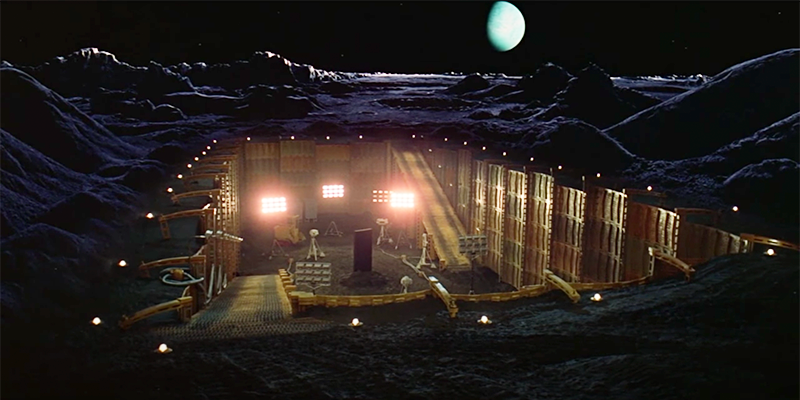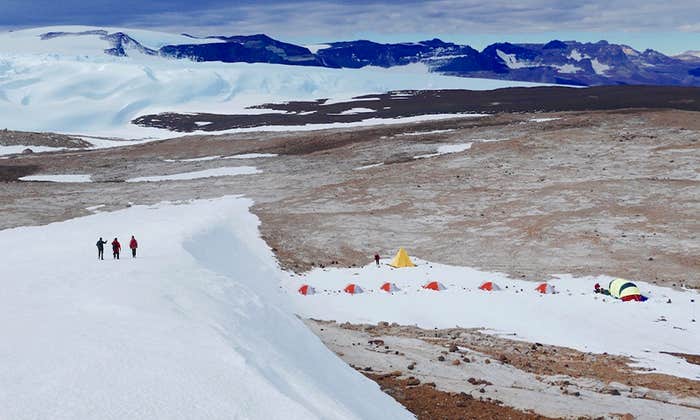In the 1968 film Planet of the Apes, a crew of human astronauts travels into the future and lands on an alien planet that a civilization of non-human primates inhabits. Only when the film’s protagonist discovers a half-buried Statue of Liberty on the shore does he realize that this is not an alien world, but rather a future Earth dominated by a new species of intelligent apes that have outcompeted humans.
The scene is as provocative today as it was 55 years ago. Homo sapiens, the futurists tell us, may one day be succeeded by another intelligent species. But how do we know another intelligent species didn’t come before us? After all, if civilization had also arisen from an earlier, now-extinct animal species, where are the ruins of its cities? If we found fossils of dinosaurs that lived tens of millions of years ago, we should also have found relics of tombs and temples built in the deep past.
Geological processes could easily erase evidence of ancient urbanization.
In 2018, climatologist Gavin Schmidt and astrophysicist Adam Frank published an intriguing paper in the International Journal of Astrobiology called, “The Silurian hypothesis: Would it be possible to detect an industrial civilization in the geological record?” The title is derived from a Doctor Who episode featuring a reptilian race known as the Silurians who gained intelligence before humans. The purpose of the Silurian hypothesis isn’t to assert that another civilization came before us. Rather, it’s a thought experiment to get us thinking about how we would know if a pre-human civilization once existed, a point that might be too subtle for some netizens in our age of Ancient Aliens memes.
Schmidt and Frank acknowledge that paleontologists haven’t uncovered fossilized evidence of pre-human civilizations—but that’s the point. If a civilization thrived millions of years prior to us, its artifacts could have been destroyed. Geological processes such as tectonic plate subduction and glaciation could easily erase evidence of ancient urbanization.

In a Planet of the Apes scenario, archeologists of a post-human civilization—let’s call them xenoarcheologists—would find remnants of a metropolis full of skyscrapers like New York City. But likely not if enough time has passed.
Schmidt and Frank write that a “species as short-lived as Homo sapiens (so far) might not be represented in the existing fossil record at all.” Today, less than 1 percent of the Earth’s surface is urbanized, a tiny proportion that hardly stands a chance of being re-exposed millions of years in the future. Unless humans continue to live on Earth for millions of years, our tenure on this planet might be far too brief to leave any trace. “Most of the surface gets completely restructured after a few million years,” Frank told me by email. “So there simply is no (almost no) old surface around which might be hiding such structures.”
Dinosaurs roamed Earth from about 245 million to 66 million years ago. If archaeologists can discover dinosaur fossils, wouldn’t xenoarcheologists discover human fossils? Probably not. At least 1,000 dinosaur species existed on Earth for 180 million years, yet for all the billions of dinosaurs that ever lived, we have only uncovered a few thousand nearly complete fossils. “We estimate that we have one dinosaur fossil for every 10,000 years—which is a tiny fraction of the ones that lived,” Schmidt said.
Anatomically modern humans have only existed for 300,000 years—about 0.2 percent as long as dinosaurs—so the prospects of xenoarcheologists finding our fossil remains millions of years in the future are slim to none. Even if a human fossil is discovered in the future, xenoarcheologists would need to find it accompanied by technological artifacts—otherwise, they might think that Homo sapiens were just another unremarkable species of ape.
However, a few clues might tell us whether we were here first. In a 2022 paper, Frank, along with the astrobiologists David Grinspoon and Sara Walker, outline several lasting signatures that an intelligent civilization like ours might leave behind. Although we might intuitively feel that a big discovery should come from hitting an archaeological jackpot, such as unearthing a landfill or the Statue of Liberty, the researchers emphasize that the most likely clues would be “global” signatures, spread across our planet.
By the turn of the last century, Frank and his colleagues write, “There were human beings on every landmass and our artifacts, from microscopic plastic debris to released fossil CO2, stretched from the deep ocean to the upper atmosphere, and even to the moon and other planetary bodies.” When fossil fuels are burned, the carbon isotopes get distributed almost uniformly around the globe. A skewed ratio of carbon isotopes would hint to xenoarcheologists that an unnatural process occurred.
“You don’t need to be super lucky to find just the right spot where something happened, the signal is being spread by the air, the water, and life itself,” Schmidt told me. Similarly, microplastics might form an ocean sediment testifying to an extinct civilization’s litter. “Sunlight is a good decomposer for plastic—as long as it’s in the light!” he said. “However, plastic that falls to the deep ocean, or gets incorporated into ocean sediments—dark, slightly acidic, anoxic environments—might have a very different lifetime, conceivably millions of years.”
Could we be looking straight at signatures of deep-space aliens and failing to recognize them?
Perhaps it’s the swansongs of bygone civilizations that leave marks in the geological record. Burning fossil fuels would not only leave a carbon signature—the resulting climate change should also appear obvious to geologists of the future. Fifty-five million years ago, the Earth warmed abruptly by more than 5 degrees Celsius. At the same time, the ratio of carbon-13 to the most abundant carbon isotope, carbon-12, sharply fell. Was this event, known as the Paleocene–Eocene Thermal Maximum, a natural occurrence brought on by exuberant volcanoes, or the demise of an industrial civilization that overheated the globe?
Although the latter possibility would be the ultimate plot twist in the story of life on Earth, Schmidt and Frank caution that “care must be taken not to postulate such a cause until actually positive evidence is available.”
Schmidt admits that his and Frank’s thought experiment has been met with a few good counter arguments. “The best one is probably the issue of deep mining,” Schmidt said. “We are mining very old deposits for metals and ore, and if these had been depleted by a prior civilization, it might have been noticed. These place limits on the scope of a prior civilization, but don’t eliminate the possibility.”
A second argument asserts that if a terrestrial civilization before humans achieved technology comparable to our own, we would find it in space. A civilization with rocket technology might leave artifacts beyond Earth, like the conspicuous alien monolith that astronauts uncover on the moon in 2001: A Space Odyssey. To look for evidence of past intelligence on Earth, we might, ironically enough, look to other worlds.
Since the beginning of the space race, humans have left numerous spacecraft on other planets and moons. Most of these artificial objects lie on our moon, which might be tectonically active but has no atmosphere. Without much of the conventional erosive processes that would chisel away at human artifacts on Earth, the Apollo landing sites will probably remain as monuments to human presence for ages.
Along these lines, a 2012 paper by astrobiologist Jacob Haqq-Misra and planetary scientist Ravi Kumar Kopparapu in the journal Acta Astronautica suggested that non-human artifacts on the moon might be identifiable by the emission of microwave or infrared radiation. So, while searching petapixels of visible light data for an odd-looking boulder might be a fool’s errand, a thermal camera could speed up the search. “The discovery of an unexpected temperature anomaly on the lunar surface,” they wrote, “could be a signature worthy of further investigation.”
Similarly, astronomer David Kipping has suggested that we should build a time capsule on the moon as a “tomb of knowledge” testifying to our existence, one that future civilizations may discover. “The moon’s going to be there for 5 billion years. That’s a long time for somebody to come by and detect, maybe, a strange pattern that we draw on the sand,” he told podcast host Lex Fridman earlier this year.
The “consensus seems to be that artifacts on the moon … have a very long life indeed,” Schmidt said. Even so, they may not last forever. In 2011, Mark Robinson, principal investigator of NASA’s Lunar Reconnaissance Orbiter mission, said in a news briefing that, “In human terms, it may seem like forever, but in geologic terms, probably there will be no traces of the Apollo exploration in, let’s say, 10 to 100 million years.” While there is no wind or water erosion on the moon, the naked landscape lies vulnerable to UV radiation, micrometeorites, and occasional macrometeorites that wear away at artifacts.
Schmidt’s and Frank’s Silurian thought experiment raises important points that could help solve the Fermi Paradox—the puzzle of why we see no signs of life elsewhere in the universe despite the vast number of other stars and planets. Could today’s astronomers already be looking straight at signatures of deep-space aliens and failing to recognize them? “It’s all connected,” Schmidt told me. In both cases—looking for a pre-human civilization on Earth or alien intelligence in deep space—“we are going to be faced with multivariate signals that could have natural causes and we are going to have to think about the conclusions in a probabilistic way.”
Schmidt himself has thought about one conclusion to a pre-human civilization. At the same time that he and Frank published “The Silurian hypothesis,” Schmidt published a short story called “Under the Sun.” This work of fiction is based on the thought experiment introduced in Schmidt and Frank’s peer-reviewed paper.
Although the Paleocene–Eocene Thermal Maximum is ambiguous, a faster and more violent civilization-ending catastrophe would leave a clearer signature. If a civilization before humans annihilated themselves in a nuclear war, radioactive plutonium left from nuclear fallout would linger for many millions of years. Plutonium cannot be formed by any natural process occurring on Earth. Its most stable isotope, plutonium-244, has a half-life of 80 million years. That’s short enough that little-to-no natural sources remain from the primordial building blocks that formed Earth, yet long enough that appreciable amounts could remain for multiple geological epochs following a nuclear conflict.
Schmidt told me that this isotope “could conceivably be a marker of a nearby supernova as well as thermonuclear war,” but the supernova possibility could be ruled out if astronomers failed to detect a corresponding nebula left behind by a star that exploded in our stellar neighborhood. In his view, finding unexpected amounts of plutonium-244 in the geological record “would be pretty significant—particularly if there were precursor anomalies in other tracers.” If the United States and Russia ever launch full-scale nuclear Armageddon on the world, it will be some small consolation to humanity that, in annihilating ourselves, we plant a plutonium flag of our existence for ages to come. ![]()
Joel Frohlich is a neuroscientist and postdoctoral researcher studying brain stimulation at the University of Tübingen’s Institute for Neuromodulation and Neurotechnology in Germany. Before moving to Germany from the United States, he spent three years as a postdoctoral researcher studying consciousness in the laboratory of Martin Monti at UCLA.
Lead image: Teo Tarras / Shutterstock




























